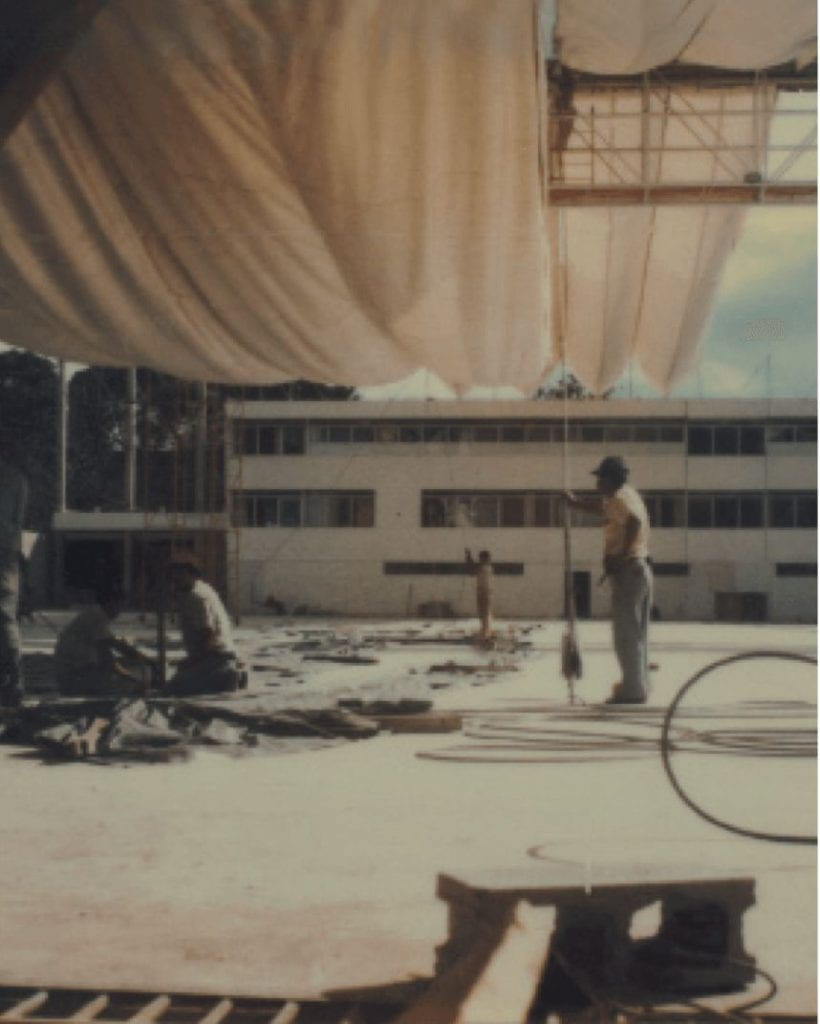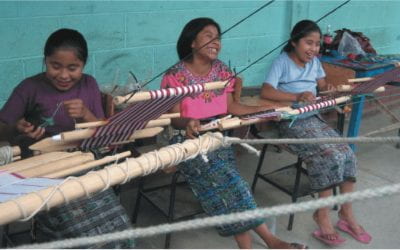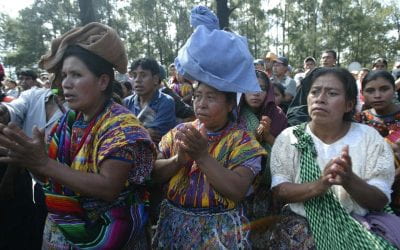Development Strategies and the 1996 Peace Accord
Promising Peace and Perpetuating Violence?
The civil war ravaged Guatemala’s social and political fabric for over three decades. It came to an official end with the signing of the 1996 Peace Accords and a sense of anticipation for the country’s future. The Accords gave rise to optimism that a reduction of violence and social injustice could be achieved through development. Yet, more than a decade after the signing and the implementation of subsequent national and international development frameworks, extreme levels of poverty, inequality and violence continue to mark the lived experience of many Guatemalans.
When I first visited Guatemala in August 2003, I saw some of the effects of the country’s insecurities and inequalities at first hand. The contrast between the city’s high-rise buildings and gated communities complete with heavily armed security guards and the simple dwellings along the road in rural Guatemala was sharp. What I remember most clearly from the trip were the impressions from the bus ride I took from Antigua to Lake Atitlán.
As I peered out the bus window, I watched many indigenous men and women in brightly woven clothing with bundles of sticks, flowers and corn walking alongside the road. I was mesmerized by the beauty of their textiles and the landscape of their home land. And distressed by the conditions of poverty in which they lived.
“If only they had increased access to markets to sell the products they are carrying,” I thought to myself, “their lives would unquestionably improve.” As an undergraduate at Harvard and at EARTH University in Costa Rica, I had been taught that development was the panacea for many social problems, and that the lack of market integration was a key obstacle to bettering the lives of small-scale farmers throughout Central America. I thought that the problems of poverty, inequality and violent conflict in Guatemala could be solved through further development. And, increased economic growth and enhanced market opportunities would improve the standards of life for the rural indigenous populations of these countries.
It has now been seven years since my first visit to Guatemala, a country I’ll return to before the year is out to conduct fieldwork for my Ph.D. studies. But this time, I find myself completely challenging my previously held beliefs that Guatemala’s problems can be solved through mainstream development practices. My research aims to develop a critique of mainstream perspectives that argue that violence is caused by a ‘lack of development’ and can be mitigated through increased economic growth and market opportunities. By following an alternative analytical approach, one that is historically grounded and that includes ethnographic fieldwork, I hope to gain a more nuanced and better understanding as to why high levels of violence and socioeconomic inequalities persist in Guatemala despite more than a decade of development strategies aimed at overcoming these problems.
Violence in Guatemala is far-reaching. In the past few years, the country has experienced rising levels of diverse forms of violence: from politically motivated violence, drug-related violence, and violence against women to countless acts of killings and kidnappings. Guatemala’s homicide rates make it one of the most violent countries in Latin America. The United Nations Office on Drugs and Crime has concluded that Guatemala’s violence can be explained by the country’s high levels of socioeconomic inequality and poverty, which appear to be “linked to both crime and human rights abuses, because of justifiable resentment on the part of the excluded and justifiable fear on the part of the advantaged.”
Violence, inequality, and poverty persist despite Guatemala’s stable economy and continued moderate economic growth since the signing of the Accords and implementation of market-led “development as economic growth” initiatives. Sustained economic growth has not led to a more equitable distribution of wealth, however. Neither has it led to widespread implementation of social policies or to improved social indicators in health, education or nutrition. Indeed, income inequalities have increased over the past several years, and Guatemala continues to have one of the lowest per capita social spending rates in the region.
Searching for the causes of the Guatemalan Civil War that took more than 200,000 lives from 1954 to 1996, the Commission for Historical Clarification (CEH 1999) concluded that the violent conflict was marked by antagonistic and discriminatory economic, political, social and cultural factors that had historical roots. The CEH determined that Guatemala’s political system was entrenched in an economic structure in which the concentration of wealth remained in the hands of the non-indigenous ladino minority. Moreover, the continued absence of an effective state social policy accentuated the historical dynamics of inequality and exclusion of indigenous groups during this time.
Conceived as a turning point in Guatemala’s history, the 1996 Peace Accords were supposed to help overcome these factors that fueled violence during the civil war. The Accords’ hundreds of substantive commitments sought to bring about significant changes to the social, economic and political structures of Guatemala. The Agreement on Identity and Rights of Indigenous Peoples (the indigenous agreement) and the Agreement on Social and Economic Aspects and the Agrarian Situation (the socioeconomic agreement) were two of the thirteen agreements that focused on overcoming socioeconomic inequalities and social exclusion in order to redress the country’s high levels of violence. These agreements spelled out the need for a more equitable distribution of wealth and resources, agrarian and land reform and increased participation of the population in development processes.
Both agreements maintained that the government had the responsibility to restore or pay compensation for plundered lands of indigenous peoples and to provide access to land for small-scale farmers. Likewise, they highlighted the importance of a more equitable distribution of wealth and of greater participation of the country’s inhabitants in development processes in order to generate political, social, and economic structures that could focus on the consolidation of peace. Though the agreements shared these development objectives, their strategies and polices put forth to achieve these aims differed greatly.
The indigenous agreement focused primarily on substantial legal reform. This legislative reform was considered necessary to protect indigenous peoples’ rights to manage their own internal affairs in accordance with customary norms, to own land collectively, and to determine their priorities with regards to social services such as health, education and infrastructure. The reform would provide a legal basis for wealth redistribution and for holding the government responsible for providing the funding to indigenous communities to achieve these goals. In contrast, policy prescriptions in the socioeconomic agreement shifted focus away from legal reform and redistribution of wealth and land in light of historical inequalities and exclusion. Instead, development strategies within the socioeconomic agreement centered on citizens “meeting their own needs” and on integration of the individual into the market.
Substantial land reform as conceived in the indigenous agreement was also rejected, as state-led land redistribution became reframed and undermined through market-oriented development prescriptions laid out in the socioeconomic agreement. Instead of compensation for or restitution of indigenous lands through legal and judicial reform, the socioeconomic agreement promoted the establishment of a transparent land market and a land trust fund to be set up within a national broad-based banking system that would provide credit and promote savings, preferably among micro-, small and medium-sized enterprises.
This adherence to market norms and market relations was also prevalent in policy prescriptions leading to increasing participation in development processes. Whereas the indigenous agreement anticipated a move away from market-based development mechanisms towards alternative social and economic frameworks, policy prescriptions set forth in the socioeconomic agreement focused on citizen participation in market-based terms. Individual market integration was deemed important in order to promote productivity, economic growth and wider use of the labor force. Hence international and national frameworks associated with achieving the development objectives laid out in the Accords also relied, almost entirely, on market-oriented mandates and neoliberal policy prescriptions to redress the country’s social problems.
This emphasis on “development as growth” and market-oriented mandates, however, is extremely problematic in the Guatemalan context. Though such approaches may increase economic growth in terms of GDP, they do very little, if anything, to substantially lessen socioeconomic inequalities and forms of violence that stem from these inequities. Without redistribution of wealth and land and provision of quality social services, reliance on these market-led development policies has actually precluded the achievement of broader objectives of social change laid out in both agreements.
Pressures from the IMF and World Bank to stabilize the economy, reduce governmental social expenditures and lift price controls on basic necessities, combined with the country’s continuing low tax levels (despite provisions set out in the socioeconomic agreement to raise taxes), have left more than half of all Guatemalans experiencing poverty and unemployment with little access to social services. The results of limited spending on social needs have also been disastrous. In the past ten years, food crises have lead to severe malnutrition and death. Almost half of all children under the age of five in the country continue to suffer from malnutrition. In the urban areas, approximately a quarter of Guatemala’s population lives in slums that lack basic services.
The deteriorating economic situation of Guatemala’s rural poor under market-led policy prescriptions, in conjunction with the desire of the elite to maintain their concentrated land holdings, has also contributed to widespread unrest in the countryside. Moreover, market-led land reform has not led to substantive land redistribution, compensation or protection of communally owned land. By the end of 2008, the government had not acted upon the 2006 recommendations of the UN Committee on the Elimination of Racial Discrimination, which outlined the government’s responsibility in adopting a national bill to demarcate historical indigenous lands and return territories traditionally owned by indigenous groups.
Overall, the mainstream (neoliberal) “development as economic growth” approach has led to continued, if not worsened, conditions of inequality, unequal land redistribution and exclusionary processes of development in Guatemala, all of which were acknowledged in the Accords as factors for violence throughout the civil war. Indeed, much of the violence in the contemporary context can be linked, at least partially, to the government’s choices in following the policy prescriptions laid out in the socioeconomic agreement.
People wanted change. The provisions of the indigenous agreement sought to transcend the existing order and to protect the rights of people to develop and participate in a range of social and economic development alternatives. Drafters of this agreement considered that new legislation and a shift away from the economic and political status quo would be necessary to ensure that indigenous lands, customary norms and rights to their own development and social processes would be protected. In other words, the indigenous agreement recognized that these objectives could not be achieved through minor reform of existing legal structures or through mainstream conceptions of development focused on market-relations.
Through my ethnographic fieldwork later this year, I hope to deepen my understanding of the linkages between development, social injustice and violence by giving a voice to people who are affected by violence in their daily lives. How do these people view the relationship between specific development policies, social and economic inequalities and violence? What are the complexities and diverse factors that influence their understanding of these issues? I also hope to articulate development alternatives offered by certain groups within the country. What sort of competing perspectives of development exist in Guatemala? Can links be drawn between these perspectives and areas of the country that are either more or less affected by violence?
The “development as growth” approach to solving the country’s social problems has not worked. Exploring development alternatives is critically important for Guatemala’s future and for bettering the lived experiences of individuals and communities throughout the country. What I have learned since that bus ride that sparked my interest in Guatemala’s social issues in the first place is that certain conceptions of development are not necessarily or always consonant with the reduction of social violence, socioeconomic inequalities and social exclusion. If competing claims of development, such as those articulated by groups involved with the drafting and signing of the indigenous agreement, are recognized and taken seriously, then social and political change that will lead to the reduction of violence and long-term peace just might be possible.
Fall 2010 | Winter 2011, Volume X, Number 1
Related Articles
Revitalizing Mayan Textiles
English + Español
What satisfaction could be greater than the joy of sharing the completion of one’s first weaving? None! This pleasure is even greater when the weaver is a young boy or girl, facing for the first time the challenge of…
Indigenous Rights and the Peace Process
English + EspañolThe Guatemalan government and the guerilla umbrella group URNG (Guatemalan National Revolutionary Unity) signed the long-awaited Acuerdo de Identidad y Derechos de los Pueblos Indígenas (Accord on Identity and Rights of Indigenous Peoples) in March 1995. Fellow anthropologist Manuela Camus and I were just finishing research on the actions and demands of Maya organizations in the context of the country’s incipient “democracy” and the peace process. As a result, we got to see first-hand the surprise and illusions that the text aroused, and the possibilities it opened for the rights and …
First Take: Guatemala, Guatebuena, Guatemaya
English + Español
“Guatemala is more of a landscape than a nation,” a friend observed in 1996 when I returned to the country after thirty years of on-and-off…





